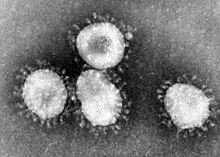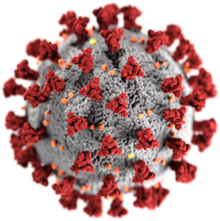
Back Koronavirus Afrikaans ኮሮናቫይረስ Amharic Coronaclēofanwyrm ANG فيروس كورونا Arabic ڤيروس كورونا ARY فيروس كورونا ARZ Orthocoronavirinae AST Koronavirus Azerbaijani کروناویروس AZB Korona BBC
| Orthocoronavirinae | |
|---|---|

| |
| Mikrograf elektron bagi virus bronkitis berjangkit virion | |

| |
| Ilustrasi morfologi koronavirus;
bentuk belantan pepaku peplomer virus, berwarna merah, menghasilkan rupa korona yang membungkus virion, apabila dilihat pada mikroskop elektron | |
| Pengelasan virus | |
| Templat taksonomi hilang (baiki): | '''Orthocoronavirinae''' |
| Genera[1] | |
| Sinonim[2][3][4] | |
| |
Koronavirus atau virus korona ialah sekumpulan virus berkaitan yang menyebabkan penyakit dalam kalangan haiwan mamalia dan burung. Virus-virus ini berupaya menjangkiti manusia bermula dengan simptom-simptom jangkitan saluran pernafasan yang ringan seperti selesema biasa (majoriti disebabkan oleh rinovirus), sehingga penyakit yang boleh membunuh seperti SARS, MERS, dan COVID-19. Gejala-gejala yang dinampakkan oleh virus korona berbeza-beza mengikut spesies yang dijangkit contohnya penyakit salur pernafasan atas untuk ayam, dan cirit-birit untuk lembu dan khinzir.
Koronavirus membentuk satu subfamili yang dikenali sebagai Orthocoronavirinae daripada famili Coronaviridae, order Nidovirales, dan alam Riboviria.[5][6] Ia diliputi virus dengan genom RNA bebenang tunggal positif dan nukleokapsid bersimetri heliks.[7] Ukuran genom koronavirus berkisar antara 26 hingga 32 kilobes, salah satu yang terbesar di antara virus RNA.[8] Virus ini mempunyai pancang berbentuk kelabu yang menonjol dari permukaannya, yang akan membentuk gambar korona suria di bawah mikrograf elektron, yang membentuk penamaannya sebagai koronavirus.[9]
- ^ "Virus Taxonomy: 2018b Release". International Committee on Taxonomy of Viruses (ICTV) (dalam bahasa Inggeris). March 2019. Diarkibkan daripada yang asal pada 4 March 2018. Dicapai pada 24 January 2020.
- ^ "2017.012-015S" (xlsx). International Committee on Taxonomy of Viruses (ICTV) (dalam bahasa Inggeris). October 2018. Diarkibkan daripada yang asal pada 14 May 2019. Dicapai pada 24 January 2020.
- ^ Fan Y, Zhao K, Shi ZL, Zhou P (March 2019). "Bat Coronaviruses in China". Viruses. 11 (3): 210. doi:10.3390/v11030210. PMC 6466186. PMID 30832341.
- ^ de Groot RJ, Baker SC, Baric R, Enjuanes L, Gorbalenya AE, Holmes KV, Perlman S, Poon L, Rottier PJ, Talbot PJ, Woo PC, Ziebuhr J (2011). "Family Coronaviridae". Dalam King AM, Lefkowitz E, Adams MJ, Carstens EB, International Committee on Taxonomy of Viruses, International Union of Microbiological Societies. Virology Division (penyunting). Ninth Report of the International Committee on Taxonomy of Viruses. Oxford: Elsevier. m/s. 806–28. ISBN 978-0-12-384684-6.
- ^ International Committee on Taxonomy of Viruses (24 August 2010). "ICTV Master Species List 2009—v10" (xls).
- ^ Cherry, James; Demmler-Harrison, Gail J.; Kaplan, Sheldon L.; Steinbach, William J.; Hotez, Peter J. (2017). Feigin and Cherry's Textbook of Pediatric Infectious Diseases (dalam bahasa Inggeris). Elsevier Health Sciences. m/s. PT6615. ISBN 978-0-323-39281-5.
- ^ Woo PC, Huang Y, Lau SK, Yuen KY (August 2010). "Coronavirus genomics and bioinformatics analysis". Viruses. 2 (8): 1804–20. doi:10.3390/v2081803. PMC 3185738. PMID 21994708.
Coronaviruses possess the largest genomes [26.4 kb (ThCoV HKU12) to 31.7 kb (SW1)] among all known RNA viruses (Figure 1) [2,13,16].
- ^ Almeida JD, Berry DM, Cunningham CH, Hamre D, Hofstad MS, Mallucci L, McIntosh K, Tyrrell DA (November 1968). "Virology: Coronaviruses". Nature. 220 (5168): 650. Bibcode:1968Natur.220..650.. doi:10.1038/220650b0.
[T]here is also a characteristic "fringe" of projections 200 A long, which are rounded or petal shaped ... This appearance, recalling the solar corona, is shared by mouse hepatitis virus and several viruses recently recovered from man, namely strain B814, 229E and several others.